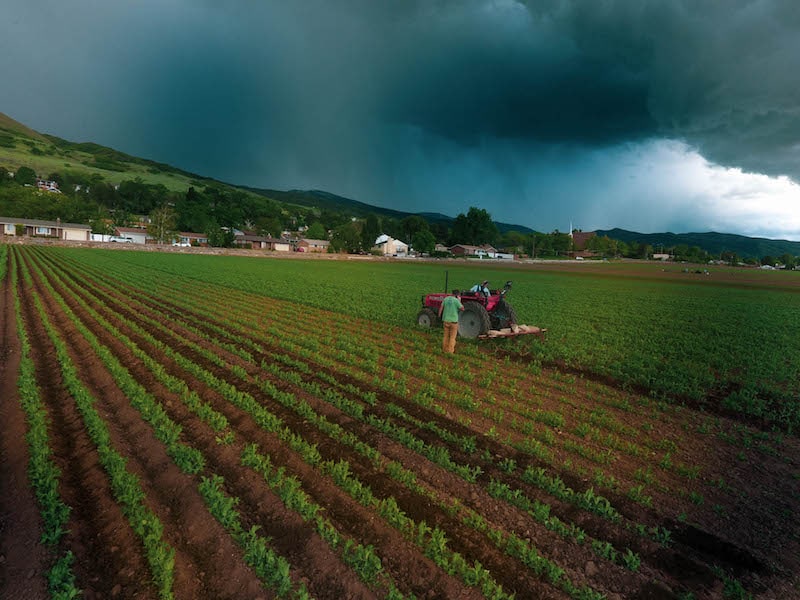
In this year’s 10th annual Farm issue, we thought we would consider taking a look back at how much our food landscape has changed here in Utah. My Grandma told me that when she was a little girl growing up in Murray, immigrant Japanese farmers were famous for their amazing produce. Other farmers raised hens for eggs, and others kept pigs or cows. Most of her family’s food supply was within ten miles of their home.
One hundred years ago, farms and cities were intimately connected. This was because most Americans still worked on farms. Consider that in 1920, around 50% of the entire workforce of Utah was working on farms, and we begin to understand the massive cultural, demographic and economic revolution that the consolidation and hyper-productivity of factory farms and supermarkets have provided to our Western society and lifestyle.
In just four generations, the main health worry of all inhabitants of the western world has shifted from starvation to obesity.
One hundred years ago, there were no suburbs. Salt Lake City dwellers only needed to ride the streetcar down State Street to see how their food was produced: farms were ubiquitous. Everyone raised a large vegetable garden. Butcher shops, bakeries, and small markets were the norm around neighborhoods. City residents bought their food at small markets. Fruit and produce stands were very common.
Today, less than one percent of our workforce is dedicated to agriculture and food production. The incredible modern marvel of factory farming made possible due to petrochemical fertilizers and massive-scale monoculture has completely transformed our food and landscape. There is almost no need for human manual labor to produce commodity crops, and these food items are so cheap to produce that the government has to pay the farmers to not over-produce. But this has major unintended consequences.
Today our food is secure, safe, ubiquitous and cheap. However, we have a complete disconnect with our farms and food. We love Costco, but who has time to cook and really consider where and how our food is produced? We grab a rotisserie chicken and pre-prepared potatoes and the kids love it. My phone has buzzed, chimed and cha-chinged four times since I started writing this, and I’ve been eating chips because I don’t have time to eat breakfast. Food is so cheap and convenient it has become an afterthought. We grow fatter, complacent and more disconnected as a result.
But things are changing: the enormous growing popularity of farmers markets are allowing small-scale farmers to make a comeback. Urban, small-scale, “market gardeners” are supplying more local restaurants. Farmers market customers (mostly urban dwellers) are making connections with farmers and love the fresh food they work so hard to provide.
The “slow-food” and “localvore” movements are gaining traction and these ideas are even spreading into the suburbs. The Wheeler Farm Farmers Market was insanely busy last week. Former “food deserts” are popping up in the most unlikely places. Read about how inner-city Detroit depopulation has created an opportunity for urban farmers. There are YouTubers focusing on helping new farmers learn to “Make $80K on less than an acre”, and they are actually doing it with the support of their community’s farmers markets and CSA programs.
It’s becoming clear that as obesity rates rise, a return to local, small-scale farming can make a huge difference. Local, fresh fruits and vegetables have up to 30% more nutritional density than fruits and veggies imported from far away. Finding the time to cook provides greater family structure and unity than fast food dinners or processed TV dinners.
But in Utah land prices even in smaller town’s real estate values are “going through the roof,” as fourth-generation orchard farmer Clark Burgess describes in this issue. Due to this, the pressure on local farmers to sell their land rather than raise food has never been greater. The only solution is to give them our continued support and encourage our government leaders to provide more incentives for local farmers to continue their operations.
MORE ABOUT UTAH FARMS
Bulldozing Utah Farms For Vacation Condos: Is this what progress looks like?
8 Agricultural Problems and Utah Farms with Solutions
Can Utah family farms thrive despite population growth?
The future of farming in Utah: an interview with Jack Wilbur, a hybrid farmer
Farms vs. Suburbia: Does Population Growth Mean the End of Family Farms?
Subscribe to Utah Stories weekly newsletter and get our stories directly to your inbox





